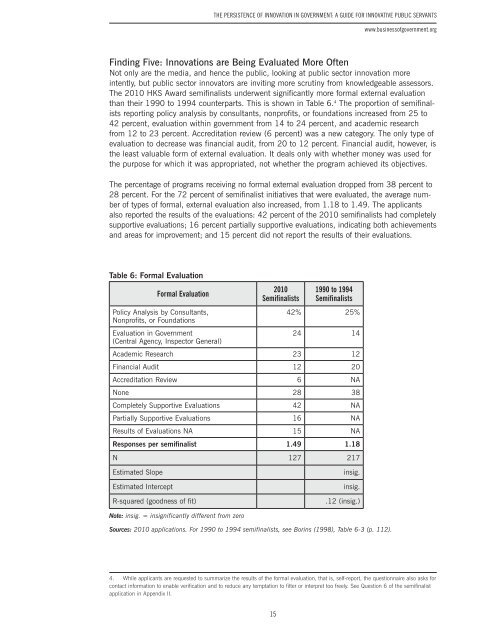The Persistence of Innovation in Government
The Persistence of Innovation in Government
The Persistence of Innovation in Government
- No tags were found...
Create successful ePaper yourself
Turn your PDF publications into a flip-book with our unique Google optimized e-Paper software.
<strong>The</strong> <strong>Persistence</strong> <strong>of</strong> <strong>Innovation</strong> <strong>in</strong> <strong>Government</strong>: A Guide for Innovative Public Servantswww.bus<strong>in</strong>ess<strong>of</strong>government.orgF<strong>in</strong>d<strong>in</strong>g Five: <strong>Innovation</strong>s are Be<strong>in</strong>g Evaluated More OftenNot only are the media, and hence the public, look<strong>in</strong>g at public sector <strong>in</strong>novation more<strong>in</strong>tently, but public sector <strong>in</strong>novators are <strong>in</strong>vit<strong>in</strong>g more scrut<strong>in</strong>y from knowledgeable assessors.<strong>The</strong> 2010 HKS Award semif<strong>in</strong>alists underwent significantly more formal external evaluationthan their 1990 to 1994 counterparts. This is shown <strong>in</strong> Table 6. 4 <strong>The</strong> proportion <strong>of</strong> semif<strong>in</strong>alistsreport<strong>in</strong>g policy analysis by consultants, nonpr<strong>of</strong>its, or foundations <strong>in</strong>creased from 25 to42 percent, evaluation with<strong>in</strong> government from 14 to 24 percent, and academic researchfrom 12 to 23 percent. Accreditation review (6 percent) was a new category. <strong>The</strong> only type <strong>of</strong>evaluation to decrease was f<strong>in</strong>ancial audit, from 20 to 12 percent. F<strong>in</strong>ancial audit, however, isthe least valuable form <strong>of</strong> external evaluation. It deals only with whether money was used forthe purpose for which it was appropriated, not whether the program achieved its objectives.<strong>The</strong> percentage <strong>of</strong> programs receiv<strong>in</strong>g no formal external evaluation dropped from 38 percent to28 percent. For the 72 percent <strong>of</strong> semif<strong>in</strong>alist <strong>in</strong>itiatives that were evaluated, the average number<strong>of</strong> types <strong>of</strong> formal, external evaluation also <strong>in</strong>creased, from 1.18 to 1.49. <strong>The</strong> applicantsalso reported the results <strong>of</strong> the evaluations: 42 percent <strong>of</strong> the 2010 semif<strong>in</strong>alists had completelysupportive evaluations; 16 percent partially supportive evaluations, <strong>in</strong>dicat<strong>in</strong>g both achievementsand areas for improvement; and 15 percent did not report the results <strong>of</strong> their evaluations.Table 6: Formal EvaluationFormal EvaluationPolicy Analysis by Consultants,Nonpr<strong>of</strong>its, or FoundationsEvaluation <strong>in</strong> <strong>Government</strong>(Central Agency, Inspector General)2010Semif<strong>in</strong>alists1990 to 1994Semif<strong>in</strong>alists42% 25%24 14Academic Research 23 12F<strong>in</strong>ancial Audit 12 20Accreditation Review 6 NANone 28 38Completely Supportive Evaluations 42 NAPartially Supportive Evaluations 16 NAResults <strong>of</strong> Evaluations NA 15 NAResponses per semif<strong>in</strong>alist 1.49 1.18N 127 217Estimated SlopeEstimated InterceptR-squared (goodness <strong>of</strong> fit)<strong>in</strong>sig.<strong>in</strong>sig..12 (<strong>in</strong>sig.)Note: <strong>in</strong>sig. = <strong>in</strong>significantly different from zeroSources: 2010 applications. For 1990 to 1994 semif<strong>in</strong>alists, see Bor<strong>in</strong>s (1998), Table 6-3 (p. 112).4. While applicants are requested to summarize the results <strong>of</strong> the formal evaluation, that is, self-report, the questionnaire also asks forcontact <strong>in</strong>formation to enable verification and to reduce any temptation to filter or <strong>in</strong>terpret too freely. See Question 6 <strong>of</strong> the semif<strong>in</strong>alistapplication <strong>in</strong> Appendix II.15


